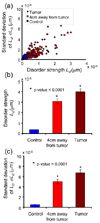Nanoscale cellular changes in field carcinogenesis detected by partial wave spectroscopy
- PMID: 19549915
- PMCID: PMC2802178
- DOI: 10.1158/0008-5472.CAN-08-3895
Nanoscale cellular changes in field carcinogenesis detected by partial wave spectroscopy
Abstract
Understanding alteration of cell morphology in disease has been hampered by the diffraction-limited resolution of optical microscopy (>200 nm). We recently developed an optical microscopy technique, partial wave spectroscopy (PWS), which is capable of quantifying statistical properties of cell structure at the nanoscale. Here we use PWS to show for the first time the increase in the disorder strength of the nanoscale architecture not only in tumor cells but also in the microscopically normal-appearing cells outside of the tumor. Although genetic and epigenetic alterations have been previously observed in the field of carcinogenesis, these cells were considered morphologically normal. Our data show organ-wide alteration in cell nanoarchitecture. This seems to be a general event in carcinogenesis, which is supported by our data in three types of cancer: colon, pancreatic, and lung. These results have important implications in that PWS can be used as a new method to identify patients harboring malignant or premalignant tumors by interrogating easily accessible tissue sites distant from the location of the lesion.
Figures



References
-
- Lewis JD, Ng K, Hung KE, et al. Detection of proximal adenomatous polyps with screening sigmoidoscopy: a systematic review and meta-analysis of screening colonoscopy. Arch Intern Med. 2003;163:413–420. - PubMed
-
- Takayama T, Katsuki S, Takahashi Y, et al. Aberrant crypt foci of the colon as precursors of adenoma and cancer. N Engl J Med. 1998;339:1277–1284. - PubMed
-
- Bernstein C, Bernstein H, Garewal H, et al. A bile acid-induced apoptosis assay for colon cancer risk and associated quality control studies. Cancer Res. 1999;59:2353–2357. - PubMed
-
- Chen L, Hao C, Chiu Y, et al. Alteration of Gene Expression in Normal-Appearing Colon Mucosa of APCmin Mice and Human Cancer Patients. Cancer Research. 2004;64:3694–3700. - PubMed
Publication types
MeSH terms
Substances
Grants and funding
LinkOut - more resources
Full Text Sources
Other Literature Sources

